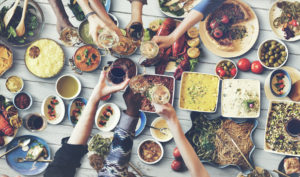
Food’s Cultural and Social Influence
How does food influence us? In more ways than we might imagine since we all participate in a “food culture.” In the U.S., influences on our food come from European cultures, our Native American roots and migratory cultures that came to the U.S. Traditions around food vary by family ancestry. Growing up in certain cultures means the Sunday dinner is a required event, or that certain foods are served for holidays and celebrations. Unfortunately, some of the worst habits we have as Americans also center around our food influences. Fast food culture, processed foods and eating on the go are all areas Americans could improve. These good and the bad influences come together to form our food culture.
The good news is, you can change culture in your own home. Learning about what all cultures do well in regards to food is a great place to start looking for examples of how to change your food culture. If you don’t know, or haven’t thought about your family’s food culture, give it some thought. Talk to older relatives about how they ate and what they ate when they were young. Research your culture on line. The internet makes research like this very easy.
Foodways
For a wealth of information on how food intersects with culture, visit The Center for Food and Culture. The center, started by Dr. Lucy Long, has a mission to “… promote an understanding of the power of food to connect individuals to past, place, and other people.” Long’s past work in a variety of fields like folklore, anthropology, American culture studies and international studies prepared her for work in the relatively new discipline of “foodways.” According to Merriam-Webster, “the eating habits and culinary practices of a people, region, or historical period.”
Long has developed various lessons to teach how food interacts with culture—she has great lessons on how to make Mexican tortillas, suggestions for visiting a Polish grocery store, and a Science, Technology & Engineering Project about composting. Although a relatively new discipline, foodways are being studied by diverse populations from Native Americans to people in the Southern states.
By studying how a culture, a region or people in a period of history interacted with food, we gain insight into those people and learn from their experience. Interest in work like Long’s has led to an increase in canning and preserving foods in the U.S. According to Michigan State University’s Extension program, email and the internet help to make older cooking methods and recipes available to younger generations.
Travel
Another method of food research is travel. Consider travel within the U.S. in order to learn about regional food influences, and travel abroad can lead you to observations about vastly different cultures. Many studies have been done about the Mediterranean diet, their use of in-season produce, as well as simple, delicious ingredient combinations and high standard for food quality are all essential to their food culture.
Ellie Krieger, writing for the Washington Post also believes that their approach to longer, more relaxed meals is an important factor in the health and lack of obesity in their country. Meals are a social event, and a priority for most Italians. Krieger quotes her tour guide as saying, “There is no word for ‘foodie’ in Italian. Food is central to everyone’s life here. It’s normal to care deeply about food.” Krieger goes on to talk about how she arrived too late for artichoke season while traveling in Italy. Consequently, recipes with artichokes were not on Italian menus because Italian restaurants do not serve a food out of season.
Food-influenced cultural research may lead you to unusual spices, or ingredients or a specific kitchen implement you have never seen before. Again, the internet makes learning about these unfamiliar spices fairly easy. The more educated we become about our food choices the easier it is for us to make healthier choices, based on the best influences from many cultures. Good research will certainly lead to good eating!





